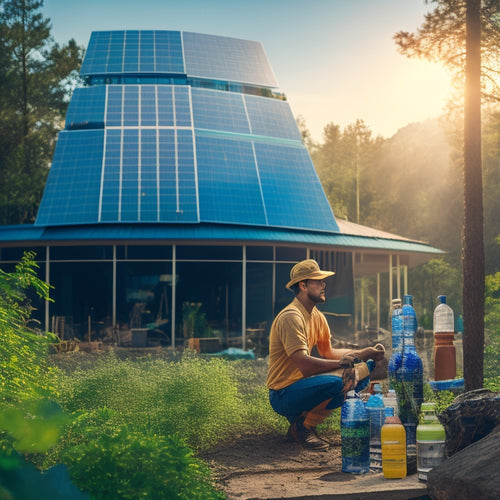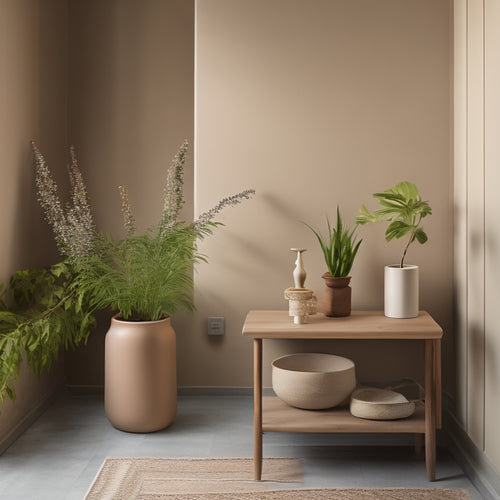
Why Build a Rain Garden for Sustainable Living?
Share
By building a rain garden, you're taking a significant step towards sustainable living. This innovative approach captures and filters stormwater runoff, reducing flooding, erosion, and water pollution, while incorporating renewable energy sources to lower your carbon footprint. Native plants that thrive in wet conditions not only provide habitat for wildlife but also enhance your property's aesthetic appeal. By utilizing rainwater, you'll reduce your water bills and support local biodiversity. Now that you've started to investigate the benefits of rain gardens, you're ready to plunge deeper into the design and implementation process to reveal their full potential.
Key Takeaways
- Rain gardens reduce stormwater runoff, mitigating flooding, erosion, and water pollution, making them a vital component of sustainable living.
- By incorporating native plants, rain gardens provide habitat for wildlife, enhance aesthetic appeal, and support local biodiversity.
- Rainwater harvesting equipment in rain gardens lowers water bills, reduces the strain on municipal water supplies, and supports water conservation.
- Rain gardens can be designed to incorporate renewable energy sources, such as solar canopies, further reducing their carbon footprint.
- Properly maintained rain gardens promote ecosystem balance, filter stormwater runoff, and support a healthier environment, contributing to a more sustainable lifestyle.
Understanding Rain Garden Basics
Designate a portion of your yard to capture and filter rainwater by creating a rain garden, a depression in the ground that collects stormwater runoff. This depression allows rainwater to slowly infiltrate the soil, reducing stormwater runoff and the pollutants it carries.
You'll reap rain garden benefits like reduced flooding, erosion, and water pollution. By incorporating renewable energy sources, such as solar canopies, into your rain garden design, you can further reduce your carbon footprint.
Native plants thrive in rain gardens, tolerating periodic flooding and drought. They also provide habitat for local wildlife and aesthetic appeal.
Choosing Ideal Rain Garden Location
When selecting a location for your rain garden, you'll want to assess your yard's drainage patterns to identify where water naturally flows.
Look for low-lying areas where water tends to collect, as these spots are ideal for your rain garden.
Consider incorporating renewable energy solutions like solar panels or wind turbines to power your irrigation system, making your rain garden even more sustainable.
Be certain to avoid areas with utility lines, such as electrical or gas lines, to guarantee a safe and successful installation.
Assess Yard Drainage Patterns
During heavy rainfall, observe how water flows across your yard, as this will help you identify the ideal location for your rain garden. Pay attention to where water collects, flows, and drains.
Check for areas with slow drainage or where water tends to pool. This will give you an idea of your yard's natural drainage patterns and help you choose a spot that can effectively capture and filter rainwater.
Consider soil types, as some may require additional drainage solutions. Look for areas with compacted or poorly draining soil, as these may need extra attention.
Effective energy management, such as energy storage solutions, can also play an essential role in sustainable living.
Additionally, understanding your yard's drainage patterns can help you design a rain garden that works in harmony with your yard's natural water flow.
Identify Low-Lying Areas
Your yard's topography plays an important role in determining the ideal location for your rain garden. To identify low-lying areas, observe how water flows through your yard during a heavy rainfall.
Note where water tends to collect or flow slowly, as these areas are prime candidates for your rain garden. Consider the soil composition in these areas as well, as it will affect the garden's ability to absorb and filter rainwater.
By leveraging fast charging infrastructure and understanding how energy storage systems optimize solar charging, you can create a sustainable solution for managing stormwater runoff.
Avoid Utility Lines
Identifying potential obstacles is essential in choosing the ideal location for your rain garden.
You'll want to avoid areas with underground infrastructure that could be damaged or compromised by your rain garden. Check for utility lines, such as electric, gas, and water, to verify your rain garden won't interfere with these essential services.
Additionally, consider the electrical infrastructure needed for commercial EV charging station installation costs and potential permits required for their installation. Call your local utility company to mark the locations of these lines on your property.
This simple step will assure utility line safety and prevent costly repairs or even personal injury. By taking this precaution, you'll be free to design and build a rain garden that effectively manages stormwater runoff while preserving the integrity of your property's underground infrastructure.
Selecting Rainwater Harvesting Equipment
You'll need to select the right rainwater harvesting equipment to guarantee your rain garden operates efficiently.
When it comes to rain barrel options, you'll consider factors like material, size, and mosquito-proofing features.
You'll also design a gutter system and choose downspout connection types that work best for your roof's structure and rainwater flow.
Rain Barrel Options
As rainfall flows over surfaces, it carries pollutants and debris that can contaminate nearby waterways. You can play a significant role in reducing this environmental impact by installing a rain barrel.
When selecting a rain barrel, you'll find various types, including plastic, metal, and wooden options. Consider a barrel made from recycled materials to further reduce your ecological footprint.
Rain barrel benefits include reducing stormwater runoff, decreasing water bills, and providing a free water source for your garden.
Look for a barrel with a sturdy design, mosquito-proof mesh, and an overflow valve to guarantee efficient water collection.
Gutter System Design
Your rain barrel is only as effective as the gutter system that directs rainwater into it. A well-designed gutter system guarantees you collect and harvest rainwater efficiently. When selecting rainwater harvesting equipment, consider the following factors:
| Gutter Type | Material | Maintenance |
|---|---|---|
| K-style | Aluminum | Low, occasional cleaning |
| Half-round | Copper | High, regular cleaning |
| Fascia-style | Vinyl | Medium, occasional cleaning |
Proper downspout design is vital, as it directs rainwater from the gutters to your rain barrel. Confirm your downspouts are securely attached to the gutters and positioned to minimize splashing and erosion. Regular gutter maintenance is necessary to prevent clogging and guarantee peak performance.
Downspout Connection Types
Flexible downspout connections guarantee a watertight seal, allowing rainwater to flow smoothly into your rain barrel.
You'll need to choose the right downspout connection type to verify efficient rainwater harvesting. Downspout diverters, flexible tubing, and decorative elements can enhance the functionality and aesthetic designs of your rain garden.
During installation, consider local regulations, water quality, and filtration methods to verify a safe and sustainable system. Proper installation techniques and maintenance tips, such as regular cleaning, can prevent clogs and overflow issues.
Additionally, overflow solutions can redirect excess water, protecting your rain garden from erosion. By selecting the right downspout connection type and following these guidelines, you'll be able to enjoy a thriving rain garden that promotes sustainable living.
Designing for Efficient Water Flow
In designing a rain garden, efficient water flow is essential to prevent erosion, reduce maintenance, and create a thriving ecosystem.
You'll want to make certain that water flows smoothly through the garden, without pooling or stagnating. To achieve this, consider the following design elements:
-
Soil types: Choose soil that drains well, such as a mix of sand, silt, and organic matter.
-
Gradient: Design the garden with a gentle slope to facilitate water flow.
-
Water flow paths: Create meandering paths for water to flow through the garden, reducing erosion and promoting infiltration.
-
Water-absorbing plants: Incorporate plants that absorb excess water, such as sedges or rushes.
-
Overflow management: Design an overflow system to handle excess water, preventing it from flowing onto surrounding surfaces.
Building Rain Garden Structure
Three key components make up the structure of a rain garden: the ponding zone, the change slope, and the overflow zone.
You'll need to design and build each zone carefully to guarantee efficient water flow and filtration. In the ponding zone, you'll use permeable rain garden materials like gravel or sand to slow down water flow and allow it to infiltrate the soil.
The change slope connects the ponding zone to the overflow zone, directing excess water away from your home. In the overflow zone, you'll implement drainage solutions like swales or channels to manage excess water.
Planting for Water Filtration
Harmony between water flow and plant life is essential in a rain garden, as vegetation plays an important role in filtering stormwater runoff.
You'll want to choose plants that flourish in wet conditions and can tolerate periodic flooding.
When selecting plants for your rain garden, consider the following:
-
Native plants are ideal, as they're adapted to local soil composition and require minimal maintenance.
-
Select plants with deep roots to help absorb and filter stormwater.
-
Incorporate a mix of plants with varying heights and growth habits to create a diverse ecosystem.
-
Avoid invasive species that can outcompete native plants and harm local biodiversity.
-
Consider using plants with natural filtering properties, such as cattails or rushes, to enhance water filtration.
Maintaining Rain Garden Health
Many rain gardens require regular upkeep to assure they continue functioning as intended.
You'll need to perform routine rain garden maintenance to guarantee peak plant health and water filtration. This includes removing debris, sediment, and excess vegetation that can clog the garden's water flow.
You should also inspect your rain garden regularly for signs of erosion, nutrient deficiencies, or pest issues. Make adjustments as needed to maintain a balanced ecosystem.
By doing so, you'll keep your rain garden thriving, filtering stormwater effectively, and supporting local biodiversity.
Frequently Asked Questions
Can Rain Gardens Be Built in Areas With Heavy Shade?
"Absence of evidence doesn't mean evidence of absence." You can build a rain garden in heavy shade, but it's essential to choose shade-tolerant plants with adapted growth habits, selecting varieties that thrive in low-light conditions to guarantee a thriving, sustainable ecosystem.
How Do Rain Gardens Affect Property Value?
You'll likely increase your property value by building a rain garden, as it enhances property aesthetics and provides environmental benefits, making your outdoor space more attractive and eco-friendly, which can appeal to potential buyers.
Are Rain Gardens Suitable for Small Yards or Spaces?
You can successfully incorporate a rain garden in small yards or spaces by prioritizing space optimization and considering design elements like narrow, winding paths and vertically-stacked plantings to maximize functionality without sacrificing aesthetics.
Can Rain Gardens Be Used for Grey Water Systems?
You think rain gardens are just for pretty landscaping? Think again! You can actually use them for grey water systems, leveraging grey water filtration to reduce your water bill while reaping landscaping benefits - talk about freedom from utility bills!
Do Rain Gardens Attract Pests or Mosquitoes?
You'll find that rain gardens, when properly designed, don't attract pests or mosquitoes; instead, they facilitate natural pest management and mosquito prevention through good water circulation, aeration, and plant selection, granting you the freedom to enjoy your outdoor space.
Related Posts
-

3 Ways Wind Power Boosts Home Value
Living near a wind farm can enhance your property's value in three significant ways. To begin with, proximity to wind...
-

What Tax Deductions Apply to Sustainable Building Materials?
You can claim various tax deductions for sustainable building materials, thanks to over 40 federal tax incentives sup...
-

What Are Natural Clay Paints for Green Home Interiors?
You're about to uncover a game-changing alternative to synthetic paints that not only enhances the aesthetic of your ...


